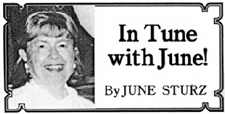“Look At Me” is a wonderful film: a modern-day fairy tale. There’s the cruel father, unloved daughter and young stepmother. It’s also about many other things, a complex narrative. The characters relate as you or I do, remaining silent when they’d rather explode. There’s a reigning gag motif-the cell phone. Virtually every scene is interrupted and controlled by chirping electronics-sound familiar? We, like everyone else, must abide.
The characters of “Look at Me” avoid discomfort, tell white lies-again, sound familiar? A major character, Lolita (and I have several thoughts about that name!), is a 20-year-old woman who has it in for the entire world because she doesn’t look like the girls in a glossy magazine-and, worst yet, she doesn’t look as good as her young stepmother. She is not a very likeable girl. Lolita simply cannot handle being herself. The ending of “Look At Me” leaves us hoping she’ll learn. The movie is in French with English subtitles: Don’t let that keep you from seeing it.
And since I mentioned the gag motif, the cell phone, please allow me to vent. When I’m on a bus, in a restaurant, in a waiting room and other public places strangers seem to have forgotten that they’re not in the privacy of their homes. Recently, while on the 99S bus, I sat in front of a young woman who had just broken up with her boyfriend. Did I need to know what a rat he was and all she had done for him? And did she have to turn the volume up on her cell so that I could also hear the one she was complaining to? Attention: Bad Cell Phone Users-pipe down, please!!
My reaction was mixed. I went to the Metropolitan Museum of Art to view a photography exhibition: “Diane Arbus Revelations.” Did I love it? No! Did I hate it? No! There were flaws and there was beauty. The contrarian Arbus appeared to revel in both. Her photographs even revealed tenderness. It seems that in her sensational art, Arbus was able to transform flaws into gifts. In the very large retrospective at the Met, the revolutionary photographer captured the New York of the 1950s and ’60s. In addition, many of her photographs include New Jersey subjects.
Being the fond grandmother of twin girls, I stopped and spent extra time at a photograph of identical twin girls photographed in New York in 1967. In the info I received from the Met, I read that Diane Arbus took many shots for this picture trying to get the just-right details of the two subjects. I guess she was successful since I learned that a signed print of the photograph of those twins sold for $478,400!
At the stirring retrospective, Arbus’ photographs and memorabilia sprawl through huge galleries. I was surprised at the size of “Diane Arbus Revelations.” Her interests appear to be connected with literature, history and art. In her work it’s almost as if she’s saying that the world is full of wondrous things. Open your eyes and recognize them.
Would it interest you to visit a spectacular site with 43-foot-tall Washingtonia palm trees, Italian marble and a European-styled courtyard plus a spectacular view of the Hudson River? It’s a dramatic glass-enclosed space offering free music and dance performances, exhibitions and festivals. Have you guessed where you can enjoy all this? It’s not far from Bayonne. Here’s a hint: Take the No. 10 bus to Journal Square, then the Path train for a less-than-10-minute ride and, voilà, you’re at the World Financial Center, 200 Liberty Street in New York City.
During the reconstruction after 9/11, the 10-story Winter Garden was restored in an amazing record of nine months (and then we gave birth!). The Winter Garden has specialty shops and restaurants (Au Mandarin and Columbus Bakery are two of my favorites) in addition to its being the perfect setting for world-class performances and events. And, don’t forget, admission is free.
Do you need more details? Then visit www.worldfinancialcenter.com. It’s an especially worthwhile trip in the spring and summer.
